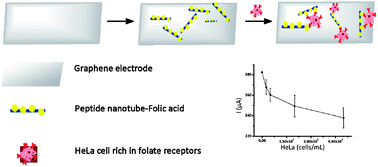Detection of cancer cells using a peptidenanotube–folic acid modified graphene electrode†
Abstract
This article describes the preparation of a

* Corresponding authors
a Centro de Investigaciones en Catálisis, Universidad Industrial de Santander, Sede Guatiguará UIS Km 2 vía Refugio, Piedecuesta, Colombia
b
Department of Micro and Nanotechnology, Technical University of Denmark, Lyngby 2800, Denmark
E-mail:
jaic@nanotech.dtu.dk
c Centro de Investigaciones en Enfermedades Tropicales, Universidad Industrial de Santander, Sede Guatiguará UIS Km 2 vía Refugio, Piedecuesta, Colombia
This article describes the preparation of a

 Please wait while we load your content...
Something went wrong. Try again?
Please wait while we load your content...
Something went wrong. Try again?
J. J. Castillo, W. E. Svendsen, N. Rozlosnik, P. Escobar, F. Martínez and J. Castillo-León, Analyst, 2013, 138, 1026 DOI: 10.1039/C2AN36121C
To request permission to reproduce material from this article, please go to the Copyright Clearance Center request page.
If you are an author contributing to an RSC publication, you do not need to request permission provided correct acknowledgement is given.
If you are the author of this article, you do not need to request permission to reproduce figures and diagrams provided correct acknowledgement is given. If you want to reproduce the whole article in a third-party publication (excluding your thesis/dissertation for which permission is not required) please go to the Copyright Clearance Center request page.
Read more about how to correctly acknowledge RSC content.
 Fetching data from CrossRef.
Fetching data from CrossRef.
This may take some time to load.
Loading related content
